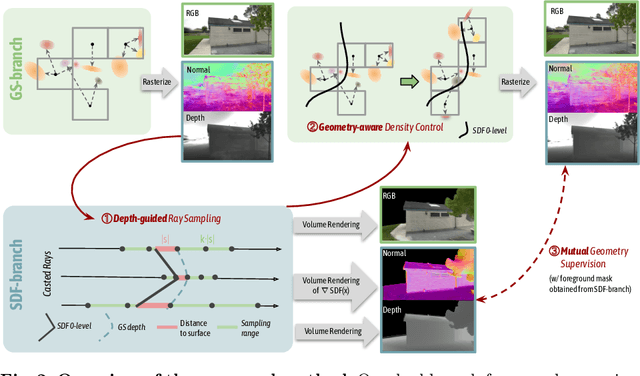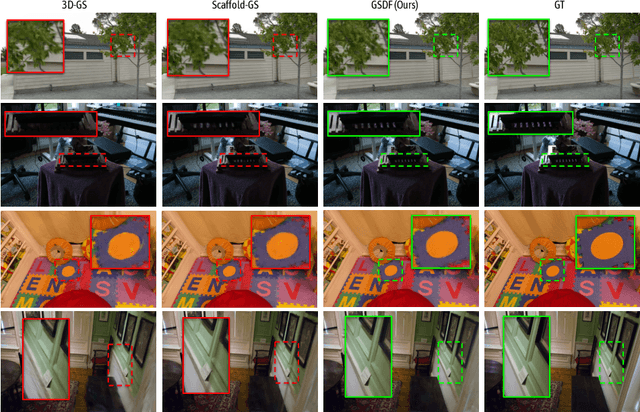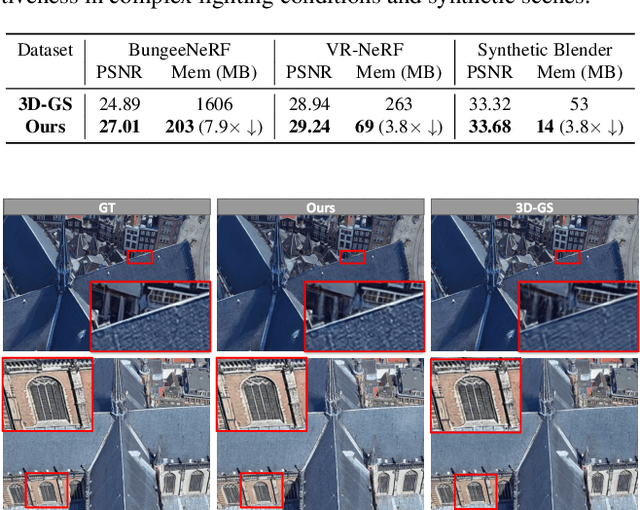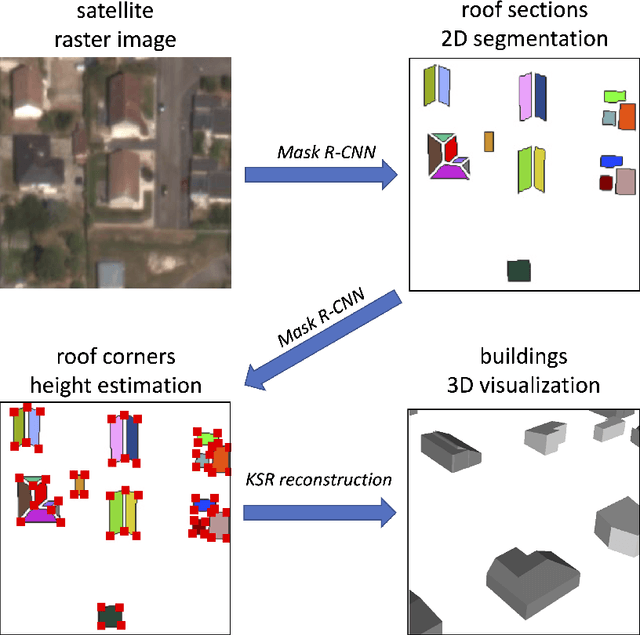Mulin Yu
Inter3D: A Benchmark and Strong Baseline for Human-Interactive 3D Object Reconstruction
Feb 19, 2025Abstract:Recent advancements in implicit 3D reconstruction methods, e.g., neural rendering fields and Gaussian splatting, have primarily focused on novel view synthesis of static or dynamic objects with continuous motion states. However, these approaches struggle to efficiently model a human-interactive object with n movable parts, requiring 2^n separate models to represent all discrete states. To overcome this limitation, we propose Inter3D, a new benchmark and approach for novel state synthesis of human-interactive objects. We introduce a self-collected dataset featuring commonly encountered interactive objects and a new evaluation pipeline, where only individual part states are observed during training, while part combination states remain unseen. We also propose a strong baseline approach that leverages Space Discrepancy Tensors to efficiently modelling all states of an object. To alleviate the impractical constraints on camera trajectories across training states, we propose a Mutual State Regularization mechanism to enhance the spatial density consistency of movable parts. In addition, we explore two occupancy grid sampling strategies to facilitate training efficiency. We conduct extensive experiments on the proposed benchmark, showcasing the challenges of the task and the superiority of our approach.
Proc-GS: Procedural Building Generation for City Assembly with 3D Gaussians
Dec 10, 2024Abstract:Buildings are primary components of cities, often featuring repeated elements such as windows and doors. Traditional 3D building asset creation is labor-intensive and requires specialized skills to develop design rules. Recent generative models for building creation often overlook these patterns, leading to low visual fidelity and limited scalability. Drawing inspiration from procedural modeling techniques used in the gaming and visual effects industry, our method, Proc-GS, integrates procedural code into the 3D Gaussian Splatting (3D-GS) framework, leveraging their advantages in high-fidelity rendering and efficient asset management from both worlds. By manipulating procedural code, we can streamline this process and generate an infinite variety of buildings. This integration significantly reduces model size by utilizing shared foundational assets, enabling scalable generation with precise control over building assembly. We showcase the potential for expansive cityscape generation while maintaining high rendering fidelity and precise control on both real and synthetic cases.
Horizon-GS: Unified 3D Gaussian Splatting for Large-Scale Aerial-to-Ground Scenes
Dec 02, 2024



Abstract:Seamless integration of both aerial and street view images remains a significant challenge in neural scene reconstruction and rendering. Existing methods predominantly focus on single domain, limiting their applications in immersive environments, which demand extensive free view exploration with large view changes both horizontally and vertically. We introduce Horizon-GS, a novel approach built upon Gaussian Splatting techniques, tackles the unified reconstruction and rendering for aerial and street views. Our method addresses the key challenges of combining these perspectives with a new training strategy, overcoming viewpoint discrepancies to generate high-fidelity scenes. We also curate a high-quality aerial-to-ground views dataset encompassing both synthetic and real-world scene to advance further research. Experiments across diverse urban scene datasets confirm the effectiveness of our method.
Octree-GS: Towards Consistent Real-time Rendering with LOD-Structured 3D Gaussians
Mar 26, 2024Abstract:The recent 3D Gaussian splatting (3D-GS) has shown remarkable rendering fidelity and efficiency compared to NeRF-based neural scene representations. While demonstrating the potential for real-time rendering, 3D-GS encounters rendering bottlenecks in large scenes with complex details due to an excessive number of Gaussian primitives located within the viewing frustum. This limitation is particularly noticeable in zoom-out views and can lead to inconsistent rendering speeds in scenes with varying details. Moreover, it often struggles to capture the corresponding level of details at different scales with its heuristic density control operation. Inspired by the Level-of-Detail (LOD) techniques, we introduce Octree-GS, featuring an LOD-structured 3D Gaussian approach supporting level-of-detail decomposition for scene representation that contributes to the final rendering results. Our model dynamically selects the appropriate level from the set of multi-resolution anchor points, ensuring consistent rendering performance with adaptive LOD adjustments while maintaining high-fidelity rendering results.
GSDF: 3DGS Meets SDF for Improved Rendering and Reconstruction
Mar 25, 2024



Abstract:Presenting a 3D scene from multiview images remains a core and long-standing challenge in computer vision and computer graphics. Two main requirements lie in rendering and reconstruction. Notably, SOTA rendering quality is usually achieved with neural volumetric rendering techniques, which rely on aggregated point/primitive-wise color and neglect the underlying scene geometry. Learning of neural implicit surfaces is sparked from the success of neural rendering. Current works either constrain the distribution of density fields or the shape of primitives, resulting in degraded rendering quality and flaws on the learned scene surfaces. The efficacy of such methods is limited by the inherent constraints of the chosen neural representation, which struggles to capture fine surface details, especially for larger, more intricate scenes. To address these issues, we introduce GSDF, a novel dual-branch architecture that combines the benefits of a flexible and efficient 3D Gaussian Splatting (3DGS) representation with neural Signed Distance Fields (SDF). The core idea is to leverage and enhance the strengths of each branch while alleviating their limitation through mutual guidance and joint supervision. We show on diverse scenes that our design unlocks the potential for more accurate and detailed surface reconstructions, and at the meantime benefits 3DGS rendering with structures that are more aligned with the underlying geometry.
Scaffold-GS: Structured 3D Gaussians for View-Adaptive Rendering
Nov 30, 2023



Abstract:Neural rendering methods have significantly advanced photo-realistic 3D scene rendering in various academic and industrial applications. The recent 3D Gaussian Splatting method has achieved the state-of-the-art rendering quality and speed combining the benefits of both primitive-based representations and volumetric representations. However, it often leads to heavily redundant Gaussians that try to fit every training view, neglecting the underlying scene geometry. Consequently, the resulting model becomes less robust to significant view changes, texture-less area and lighting effects. We introduce Scaffold-GS, which uses anchor points to distribute local 3D Gaussians, and predicts their attributes on-the-fly based on viewing direction and distance within the view frustum. Anchor growing and pruning strategies are developed based on the importance of neural Gaussians to reliably improve the scene coverage. We show that our method effectively reduces redundant Gaussians while delivering high-quality rendering. We also demonstrates an enhanced capability to accommodate scenes with varying levels-of-detail and view-dependent observations, without sacrificing the rendering speed.
3D detection of roof sections from a single satellite image and application to LOD2-building reconstruction
Jul 11, 2023



Abstract:Reconstructing urban areas in 3D out of satellite raster images has been a long-standing and challenging goal of both academical and industrial research. The rare methods today achieving this objective at a Level Of Details $2$ rely on procedural approaches based on geometry, and need stereo images and/or LIDAR data as input. We here propose a method for urban 3D reconstruction named KIBS(\textit{Keypoints Inference By Segmentation}), which comprises two novel features: i) a full deep learning approach for the 3D detection of the roof sections, and ii) only one single (non-orthogonal) satellite raster image as model input. This is achieved in two steps: i) by a Mask R-CNN model performing a 2D segmentation of the buildings' roof sections, and after blending these latter segmented pixels within the RGB satellite raster image, ii) by another identical Mask R-CNN model inferring the heights-to-ground of the roof sections' corners via panoptic segmentation, unto full 3D reconstruction of the buildings and city. We demonstrate the potential of the KIBS method by reconstructing different urban areas in a few minutes, with a Jaccard index for the 2D segmentation of individual roof sections of $88.55\%$ and $75.21\%$ on our two data sets resp., and a height's mean error of such correctly segmented pixels for the 3D reconstruction of $1.60$ m and $2.06$ m on our two data sets resp., hence within the LOD2 precision range.
 Add to Chrome
Add to Chrome Add to Firefox
Add to Firefox Add to Edge
Add to Edge